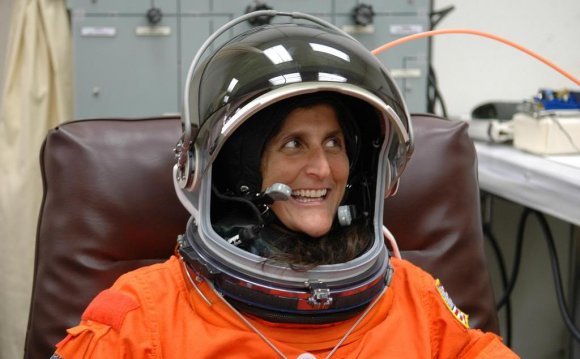
Astronauts are persons trained to fly or operate systems aboard a spacecraft. "Astronaut" is the term typically applied to those who fly on U.S. spacecraft, whereas "cosmonaut" refers to crewmembers who have flown on Russian space vehicles. The National Aeronautics and Space Administration (NASA) selected the first American astronauts in 1959 to pilot the single-seat Mercury spacecraft. These "Original 7" were all chosen from the ranks of military test pilots.
Qualifications for these first astronauts were extremely high. Not only were the Mercury and Gemini astronauts professional test pilots, but they also had to meet strict standards for eyesight, health, and physical size (because of the tight confines of the spacecraft cockpits). In advance of the Apollo Moon landings, six scientists were selected for astronaut training in 1965, but only one made it to the lunar surface (compared with eleven former test pilots) before the Apollo program ended in 1972.
NASA drew up new qualifications for astronauts in 1978, with the advent of the space shuttle. The shuttle cabin could handle crews of up to seven astronauts, and its varied missions required a broader mix of skills from an array of technical backgrounds. Scientists, engineers, and physicians were now eligible for selection, and prior flying experience was no longer mandatory. Current shuttle astronaut candidates apply for one of two career positions: pilot astronaut or mission specialist astronaut.
Pilot astronauts have primary responsibility for guiding the space shuttle safely to and from orbit. Pilot astronaut candidates must have professional test piloting experience; most gain that skill in the military. Shuttle pilots monitor the controls during liftoff, maneuver the spacecraft in orbit, guide the shuttle to dockings with the space station, and fly the shuttle back to a precision runway landing. Pilot astronauts fly first as a copilot and, with experience, advance to command of a shuttle mission.
Mission specialist astronauts train to operate the space shuttle's experiment and conduct a variety of activities in orbit. They have primary responsibility for science tasks and assist the pilots with spacecraft operations. Mission specialists maneuver the shuttle's robot arm to release or retrieve satellites. They also conduct space walks for satellite repairs or space station construction. Experienced mission specialists serve as "payload commanders, " responsible for controlling a major scientific payload or suite of experiments.
A typical shuttle crew is composed of two pilots and anywhere from three to five mission specialists, depending on the mission's complexity. The crew trains intensively as a team for a year or more to prepare for a mission. The crew may include a "payload specialist, " a scientist or engineer from outside the astronaut corps, selected to operate a specific experiment aboard one or two shuttle flights.
Space station crews consist of a commander and two or more flight engineers, with the role of the latter being similar to that of mission specialists. Station crewmembers are drawn from the astronaut corps of the United States, Russia, and the other countries that are international partners. Another category of astronaut—one involved in commercial activities—may soon go to work aboard the International Space Station.
see also Career Astronauts (volume 1); Careers in Spaceflight (volume 3); Cosmonauts (volume 3); Mission Specialists (volume 3); Payload Specialists (volume 3).
Thomas D. Jones
Bibliography
National Aeronautics and Space Administration. Astronaut Fact Book. Houston, TX:Johnson Space Center, 1998.
Internet Resources
Astronaut Biographies. National Aeronautics and Space Administration. .
NASA Human Spaceflight. National Aeronautics and Space Administration. .
Backpacks, Portable See Life Support (Volume 3).
Jones, Thomas D.. "Astronauts, Types of." Space Sciences. 2002. Retrieved February 20, 2016 from Encyclopedia.com:
Learn more about citation stylesCitation styles
Encyclopedia.com gives you the ability to cite reference entries and articles according to common styles from the Modern Language Association (MLA), The Chicago Manual of Style, and the American Psychological Association (APA).
Within the “Cite this article” tool, pick a style to see how all available information looks when formatted according to that style. Then, copy and paste the text into your bibliography or works cited list.
Because each style has its own formatting nuances that evolve over time and not all information is available for every reference entry or article, Encyclopedia.com cannot guarantee each citation it generates. Therefore, it’s best to use Encyclopedia.com citations as a starting point before checking the style against your school or publication’s requirements and the most-recent information available at these sites:
Notes:
- Most online reference entries and articles do not have page numbers. Therefore, that information is unavailable for most Encyclopedia.com content. However, the date of retrieval is often important. Refer to each style’s convention regarding the best way to format page numbers and retrieval dates.
- In addition to the MLA, Chicago, and APA styles, your school, university, publication, or institution may have its own requirements for citations. Therefore, be sure to refer to those guidelines when editing your bibliography or works cited list.
RELATED VIDEO












